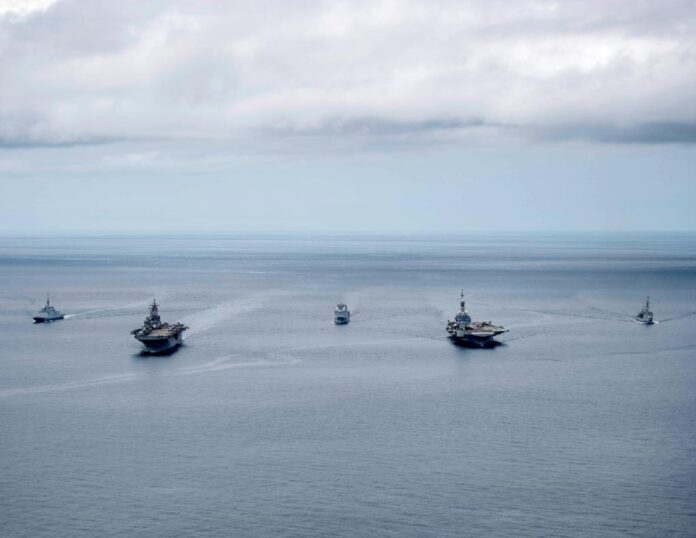For decades, the Andaman Sea was viewed as a serene expanse of blue, a calm passage connecting the Indian Ocean to the bustling Strait of Malacca. Fishing boats, cargo ships, and regional navies passed through its waters with little fanfare. But beneath the surface, change was brewing.
In recent years, this seemingly quiet corner of the Indo-Pacific has become a theatre of mounting strategic tension. As China pushes its maritime ambitions farther west, its vessels, both military and research, have begun probing the depths of the Andaman Sea, mapping the seabed and signalling its expanding reach. In response, India has quietly but steadily fortified its presence across the Andaman and Nicobar Islands, recognising the sea’s growing strategic weight.
Meanwhile, the region’s undercurrents aren’t just geopolitical. Traffickers have turned their waters into a covert highway, ferrying drugs and people across borders under the radar. In one recent bust, Indian authorities intercepted a massive Myanmar vessel carrying over 6,000 kg of methamphetamine, a shocking reminder of how lawless parts of this sea have become.
From covert power plays to illicit trafficking, the Andaman Sea is no longer just a blue blot on the map. It’s fast becoming the Indo-Pacific’s forgotten flashpoint, and the world is only beginning to take notice.
Strategic Significance of Indo-Pacific
Power, trade, and influence are converging in the Indo-Pacific like never before. This sprawling maritime region, spanning from Africa’s eastern rim to the Pacific archipelagos, is quickly becoming the world’s most contested and consequential theatre. At the heart of this strategic chessboard lies the Strait of Malacca, a lifeline for nearly a quarter of global trade and a vital artery for energy imports into East Asia. The Andaman Sea, positioned just before this chokepoint, quietly holds immense leverage in shaping the region’s security architecture.
The Indo-Pacific’s significance runs deeper than commerce. It’s where military buildups, diplomatic realignments, and technological rivalries are playing out in real time. From India’s growing naval footprint to China’s expanding maritime influence, the waters are increasingly crowded and contested. With ASEAN nations enhancing defence ties and the Quad pushing for a rules-based maritime order, the Indo-Pacific is no longer just a geography — it’s a litmus test for future global stability.
How regional powers navigate this complex environment will define the balance of power for decades to come, and the Andaman Sea, once overlooked, may prove to be one of its most telling fault lines.
Emerging Security Challenges
The region faces a confluence of security challenges:
- Geopolitical Rivalries: China’s expanding maritime footprint, marked by increased naval patrols and seabed mapping activities, has raised concerns among neighboring countries. India, viewing the Andaman and Nicobar Islands as pivotal to its maritime strategy, has responded by enhancing its naval capabilities and infrastructure in the area.
- Non-Traditional Threats: The Andaman Sea has witnessed a surge in illicit activities, including human trafficking and drug smuggling. Notably, Indian authorities recently intercepted a Myanmar vessel carrying over 6,000 kg of methamphetamine, highlighting the region’s role in transnational narcotics networks.
- Environmental Concerns: The delicate marine ecosystem faces threats from illegal fishing practices and potential ecological degradation, which could disrupt local livelihoods and biodiversity.
Regional Responses and Implications
In response to growing strategic tensions and the shifting power dynamics of the Indo-Pacific, regional players are actively recalibrating their approaches to safeguard maritime stability, especially in the Andaman Sea.
India, acutely aware of the Andaman Sea’s growing geostrategic value, has intensified its military posture by strengthening naval installations, airstrips, and surveillance capabilities across the Andaman and Nicobar Islands. These upgrades are designed not only to enhance maritime domain awareness but also to provide India with a forward-operating base to monitor the eastern Indian Ocean and the Strait of Malacca.
On a broader level, multilateral cooperation is gaining momentum. The Quadrilateral Security Dialogue (QUAD)—comprising India, the United States, Japan, and Australia—has repeatedly underscored the need for a free, open, and rules-based Indo-Pacific. The QUAD’s coordinated naval drills, interoperability initiatives, and intelligence sharing reflect a growing commitment to deterring coercive actions and ensuring freedom of navigation in contested waters. As the Andaman Sea edges closer to the strategic spotlight, these collaborative efforts will play a pivotal role in shaping the regional security architecture.
The Andaman Sea’s evolving dynamics reflect broader shifts in the Indo-Pacific’s security architecture. As geopolitical rivalries intensify and non-traditional threats proliferate, the region’s stakeholders must navigate a complex maritime landscape. Ensuring stability in the Andaman Sea is not only crucial for regional actors but also for the broader international community, given its pivotal role in global trade and security.



